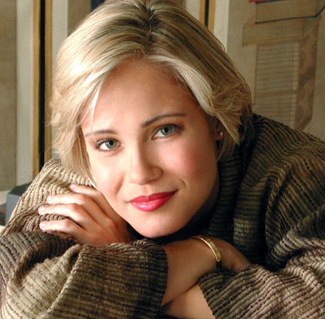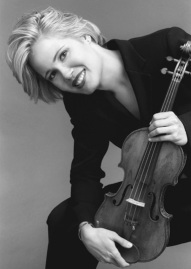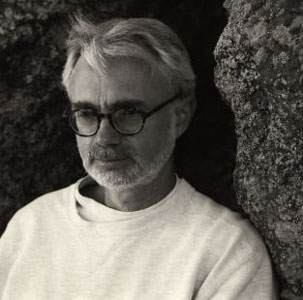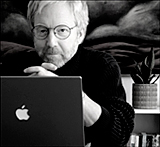Leila Josefowicz: The Dharma of The Violin
By Stephen Brookes • The Washington Post • May 3, 2007
___________________________________________________________________________________
It's probably lucky for the world that Leila Josefowicz isn't tall. The brilliant young violinist once spent a year as a top model for Chanel, acting as the face of Allure perfume. But her short stint in the fashion world ended almost as soon as it began. "I'm not tall enough to be a model," says Josefowicz, who tops out at a modest 5 feet 5. "I'm tiny! No one's interested in me!"
 Well -- that may be a bit of an over-statement. At 29, Josefowicz has emerged as one of the more thought-provoking and distinctive violinists in the world, winning accolades for her radiant tone, consummate technique and fierce sense of adventure. She brought a rarely heard concerto by Paul Hindemith to the Kennedy Center in January, and this week she'll be playing John Adams's "The Dharma at Big Sur" with the Baltimore Symphony Orchestra -- a work so radical she had to have a six-string electric violin called the "Violectra" built to play it.
Well -- that may be a bit of an over-statement. At 29, Josefowicz has emerged as one of the more thought-provoking and distinctive violinists in the world, winning accolades for her radiant tone, consummate technique and fierce sense of adventure. She brought a rarely heard concerto by Paul Hindemith to the Kennedy Center in January, and this week she'll be playing John Adams's "The Dharma at Big Sur" with the Baltimore Symphony Orchestra -- a work so radical she had to have a six-string electric violin called the "Violectra" built to play it.
"It's an incredible piece -- it just overtakes you," she says of the half-hour concerto. "It's so daring, and it just builds and builds and builds to an incredible, emotional climax. By the end, you think the hall's going to explode."
The explosiveness, though, is just as likely to come from Josefowicz herself. A driven, Toronto-born prodigy, she began playing the violin at the age of 3, made her Carnegie Hall debut at 16, then graduated from the prestigious Curtis Institute of Music in Philadelphia and recorded the violin concertos of Tchaikovsky and Sibelius while still in her teens.
But even as her career took off, Josefowicz faced an unusual hurdle: her own good looks. By the mid-1990s, the classical field had become swamped with attractive young female musicians -- Vanessa-Mae, Lara St. John and Ofra Harnoy, to name just a few -- and industry marketers were encouraging them to perform in miniskirts, pout for the camera and generally play the sex kitten. Many did; St. John even posed topless, with a discreetly positioned violin, for her debut CD, while violinist Linda Brava bared all for Playboy.
Despite the trend -- Josefowicz was mentioned in a Time magazine article titled "Seductive Strings: Concerto for Cleavage and Orchestra" -- she stayed buttoned up.
 "Part of it is plain old self-respect," the artist says, in a backstage interview during her earlier visit to Washington. "I've worked so hard for so many years, why distract people with something that has nothing to do with my skill? It doesn't mean you have to be dowdy -- it just means don't throw a twist like that into the mix!"
"Part of it is plain old self-respect," the artist says, in a backstage interview during her earlier visit to Washington. "I've worked so hard for so many years, why distract people with something that has nothing to do with my skill? It doesn't mean you have to be dowdy -- it just means don't throw a twist like that into the mix!"
But when, at 20, Chanel came knocking, she couldn't resist -- and soon found her face staring from magazines over ad copy like: "No more top, middle and bass notes. Allure dispenses with these traditional notions to embrace a multifaceted approach."
Now the whole episode just makes her laugh.
"It's wrong to be selling what sex you are, instead of your art. But Chanel was classy -- it's okay to be classy!" And she insists she didn't make much of a sex symbol anyway: "When I walked on for the Chanel shoot, I was six months pregnant! I was, like, 'Hey, you guys want a twig? Well -- here ya go!' " (She was married at the time to the Estonian-born conductor Kristjan Järvi.)
The violinist's brief foray into modeling may just reflect a restless curiosity. She's friends with writer Anne Rice -- who once dedicated a novel to her -- and her conversation sails effortlessly from rock-and-roll ("Led Zeppelin has a kind of realness that's missing from today's bands") to architecture ("I think Santiago Calatrava is a genius") to fashion design ("Yohji Yamamoto completely changes how you think of the human body").
But her real commitment remains with contemporary classical music. She memorizes everything she performs (including the orchestral parts), so that she's "never worrying about things that shouldn't be mattering," and has become a friend and collaborator with some of the world's top composers, including John Harbison, Oliver Knussen, Steve Mackey and John Adams himself.
"When you meet him, you realize how out of the ordinary he is," she says of Adams, who, at 60, may be the most acclaimed composer in America. "He's had the greatest training as a composer, but he's really an extremely free spirit. And in 'Dharma,' that free spirit just takes over."
Commissioned for the 2003 opening of the Walt Disney Concert Hall in Los Angeles, "The Dharma at Big Sur" took its initial inspiration from Adams's own sense of awe when -- as an Easterner -- he first encountered the Pacific Coast. But the composer soon became intrigued with the playing of electric violinist Tracy Silverman, which reminded him, he later wrote, that "in almost all cultures other than the European classical one, the real meaning of the music is between the notes" -- in the slides, portamenti and blue notes that are essential to expression.

John AdamsAdams steeped himself in non-European music, listening to everything from the string instruments of India and Afghanistan to Pakistani qawwali singers like Nusrat Fateh Ali Khan, and studied the writings of beat poet Jack Kerouac -- whose book "Big Sur," Adams wrote, "oscillates between turbulence and ecstasy."
What finally emerged was a work that sounds like nothing else -- a surging, almost oceanic concerto that's not really Eastern, not really Western, and barely even of this solar system. Most of the instruments are tuned according to their natural harmonic overtones -- what's called "just intonation," rather than the modified "tempered" tuning that Western ears are used to -- giving the work a rich, exotic flavor. It also sounds utterly improvised. As the orchestra gently undulates, spinning out long, shimmering chords, the electric violin soars rhapsodically overhead -- a kind of otherworldly bird gazing down on a landscape of boundless possibilities.
"It's a kind of spiritual journey, a very personal piece," says the BSO's Marin Alsop, who will be conducting the performance. "It's very meditative, and extremely liquid and flowing -- a new dimension of his personality. And I'm very excited about doing it with Leila. She's very hip, and she really makes a piece of music her own."
"This is the stuff that gets me passionate about what I do," Josefowicz says. "I love the standard works, but you have to also have that adventurous side. I'm trying to do things that are unusual, that are totally different, that will give people a new musical experience. I'm trying to make as much of a difference as one person can."
Leila Josefowicz will perform with the Baltimore Symphony Orchestra tonight and tomorrow night at Meyerhoff Symphony Hall in Baltimore. The program also includes works by Mahler and Rimsky-Korsakov.


Reader Comments (1)